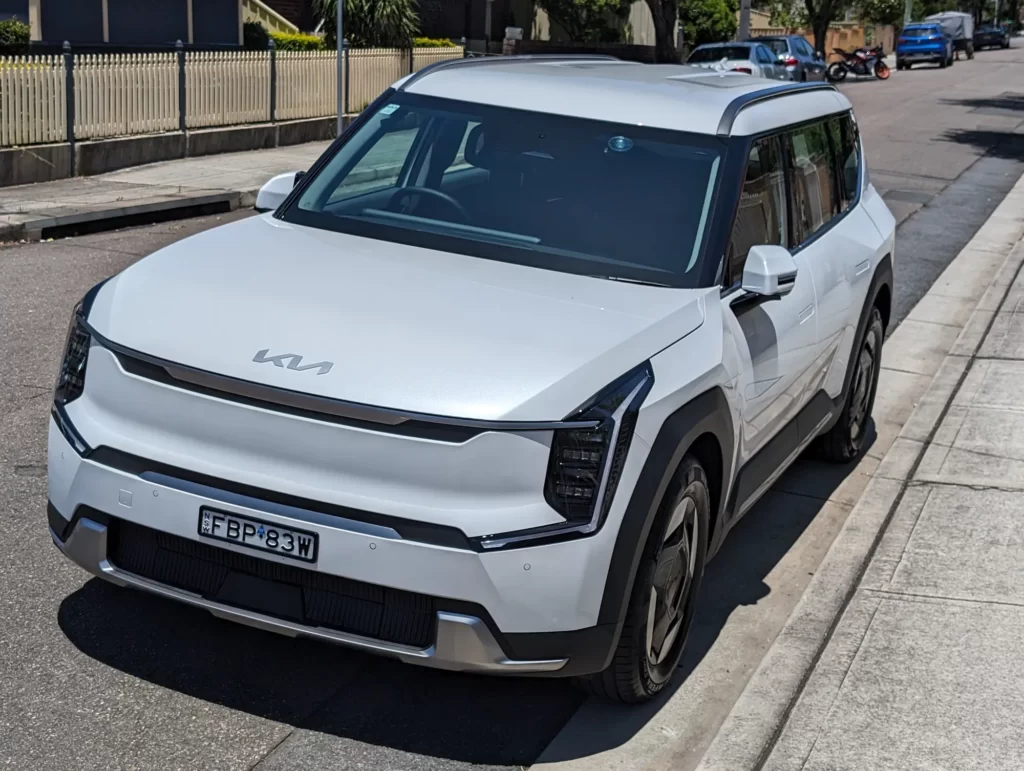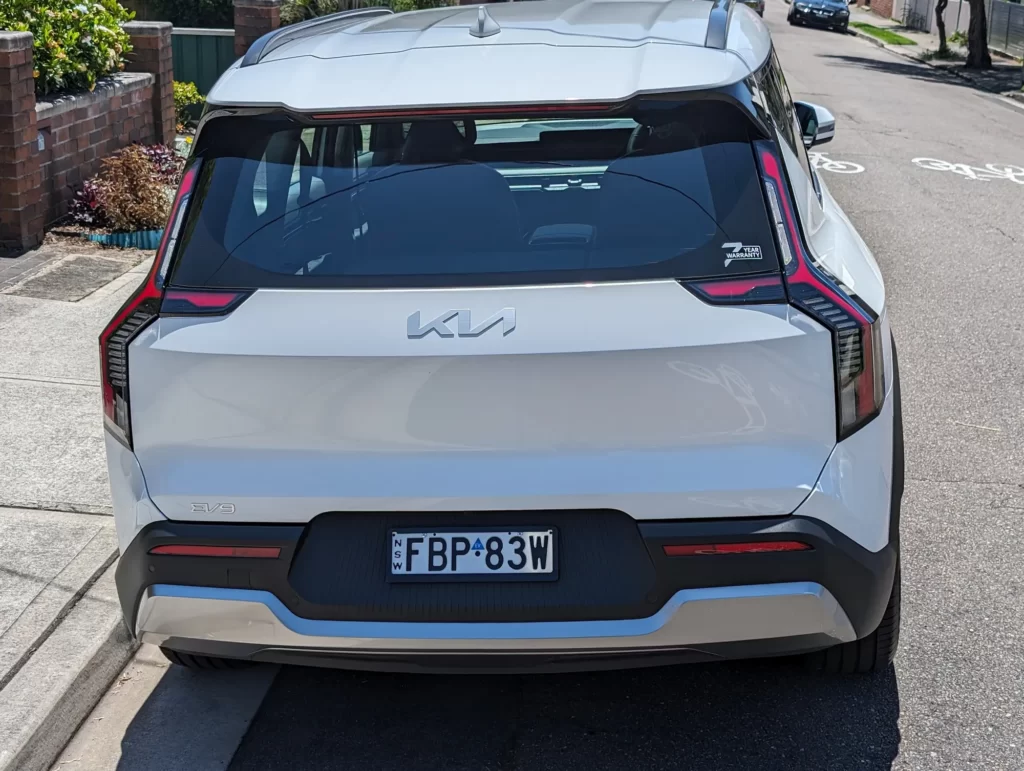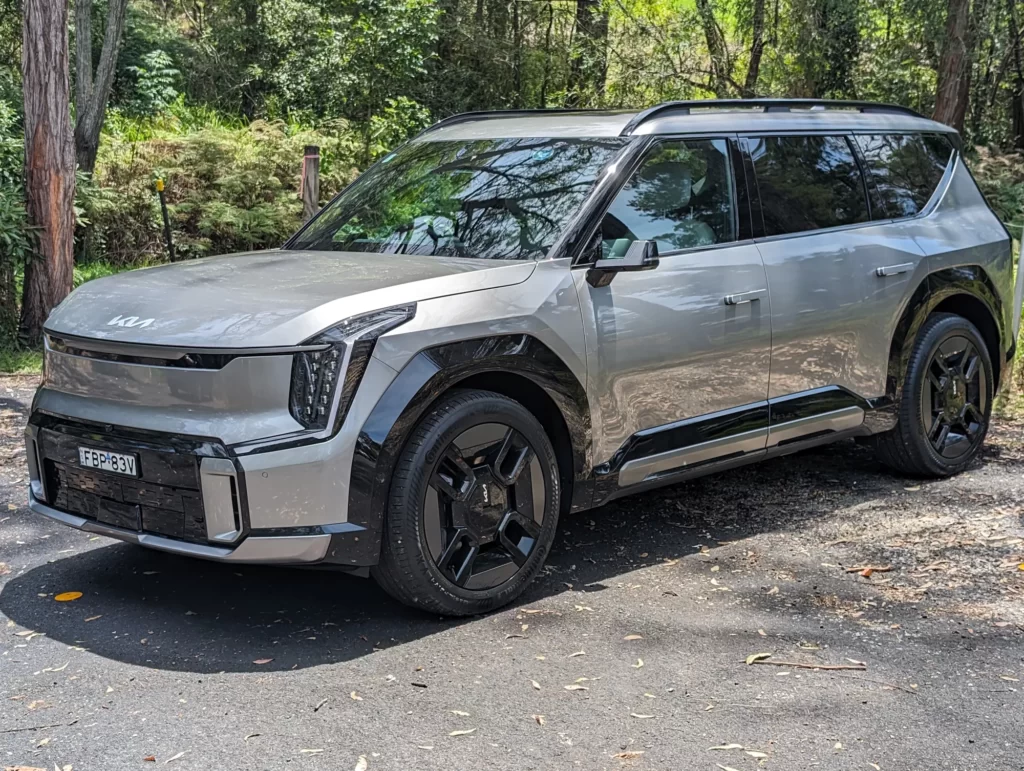I recently drove 335km in Australian media loan Kia EV9 Air and GT-Line 2023 model electric cars for a total of 10 days across both cars.
I didn’t get to drive the mid spec Earth version but based on driving the base Air and top end GT-Line I think the Earth is probably the best option as it has a 360 camera, normal side mirrors instead of digital ones and the longest WLTP range at 512km vs Air 443km and GT-Line 505km.
Disclosure: The cars were loaned by Kia Australia for me to do an independent media review. I agreed to meet all the associated running costs e.g. tolls, charging etc.


If you’re thinking of buying a Kia EV9 bear in mind that it is quite a big car in height, width and length so it is very tricky to manoeuvre on tight streets eg when Waze decided to send me down Darley St Newtown.
As you can see in my dashcam photo above there was very little space to drive through due to the parked cars on both sides.
It’s also harder to find street parking. At night I had to park on a nearby street which had more room, instead of my own street.
Realistically though anyone who buys a Kia EV9 in Australia will own their own big house and have at least a private off street driveway if not a garage as well.
See the full visual size comparison between a Kia EV6 and Kia EV9 at CarSized.

The longest day driving was 151km in the GT-Line from Marrickville to Blaxland in the lower Blue Mountains, then to Chatswood and back to Marrickville. This involved a good mix of fast highway driving, medium speed suburban driving and slow peak hour driving home. Efficiency for this trip was 18.8 – 20.8kWh/100km. The temperature was 31C that day and I drove in Normal Mode.
During a 50km return drive from Marrickville to Liverpool mostly on the M5 motorway and back, GT-Line efficiency was 20kWh/100km. The temperature was 27C that day and I drove in Normal Mode.
Otherwise there were lots of short less than 10km trips in the Air and GT-Line and I used a lot of air-conditioning for these trips while driving and for remote pre-cooling the car as these trips were mostly during days that Sydney was quite hot close to 40C.
Overall the efficiency was 18.1kWh/100km for the Air model (for city driving only) and 22.2kWh/100km for the GT-Line (mixture of highway and city driving).
Exterior Photos






Interior Photos






What I Liked
Everything about the 7 seater Kia EV9 car is massive, even the doors are huge, heavy and chunky.
Since it’s designed from scratch to be an electric car, it has even more space on the inside than you would expect for a similarly sized petrol car.
This car has plenty of space to fit in lots of people or lots of stuff you need to transport.
Checkout my article Australian Kia EV9 Air Earth GT-Line 2023: how much storage space is in boot and frunk?
However it does not have the as much space as a 8 seater Kia Carnival fossil fuel powered car. A friend who owns one of those drove theirs over to compare against the EV9 and they were disappointed at the boot space if all 3 rows of EV9 seats were occupied.
The 2nd row of seats can be closed down with buttons in the boot. The 3rd row of seats can be closed down by pulling a strap on the front side of them.

Despite being so large and heavy this car is deceptively fast, the GT-Line can do 0-100km in 5.3 Seconds!
Coupled with the interior sound level being very well insulated from outside, it’s very easy to go fast so keep a close eye on your speedo in urban areas.
The switchable digital rear mirror camera feature in the GT-Line spec is extremely useful as it will massively improve your rear visibility, especially if the back seats are all full.


All versions of the Australian Kia EV9 have Kia Connect app functionality. Check out my video below to see remote climate control and a scroll through of all the key features.
What Could Be Better
The Kia EV9 GT-Line spec uses the same shared Hyundai Motor Group digital side mirror tech as the Genesis GV60 I reviewed recently.
I do not like digital side mirrors. They are a technology solution fixing a problem that doesn’t exist. Thankfully the Air and Earth spec have traditional side mirrors.
The left-hand side digital mirror one is kind of useful but the right hand one is too close to me, an uncomfortable angle to view from my height of 1.91m and occasionally hard to focus on.

As you can see below the EV9 Air model only has a reverse camera instead of 360 degree cameras like the Earth and GT-Line specs.
The Air also doesn’t have PCA (Parking Collision Avoidance Assist) for reverse, side or forward!
Not having these sensors and good quality 360 cameras is unacceptable for any EV above 60K, let alone the Kia EV9 Air which costs over $100,000 driveaway in NSW.
The Earth spec has PCA (Parking Collision Avoidance Assist) for reverse and the GT-Line has all 3 PCA (Parking Collision Avoidance Assist) sensors.


Viewing the air conditioning controls on screen is blocked by the steering wheel. This is a fairly basic design fail not ensuring a key car feature is in the drivers line of sight.


I always say this when I review a Kia or Hyundai EV but I wish they remembered my preferred maximum regen i-Pedal setting.
It always resets to Level 3 strength on car startup instead of full i-Pedal mode. Similarly i-Pedal annoyingly turns off if you reverse and resets to level 3 regen.

The car plays annoyingly loud bong and beep sounds when it sees a truck speed limit that is lower than the car highway speed limit and it thinks you’re speeding by over 10 km.
Traffic sign recognition also detects highway off ramp speed limits and loudly warns you that you’re going above 70km when the speed you can really go at is 100km.
On the plus side the warning beeps for going through a school zone when it is not school zone timing are not as loud as some other cars.

Leave a Reply